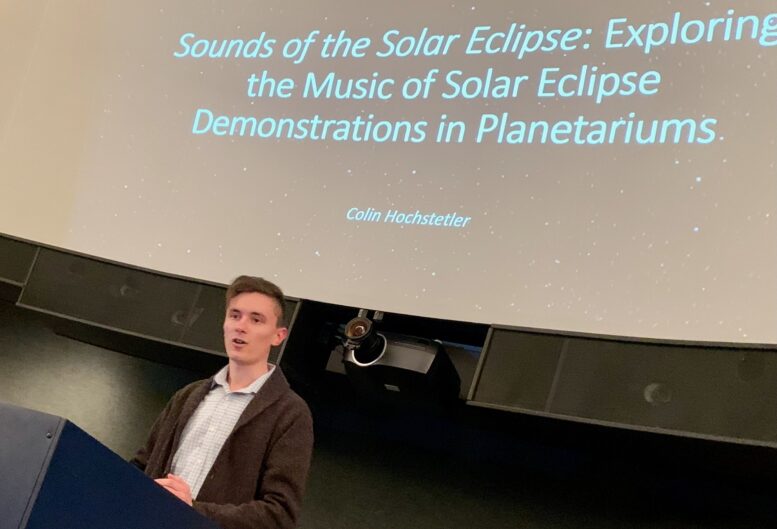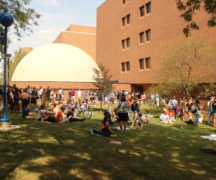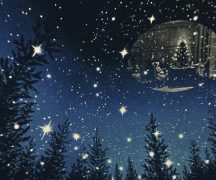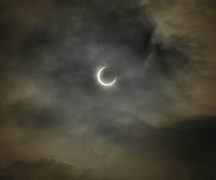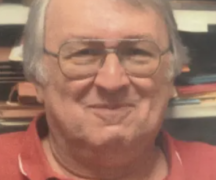By JULIE CARLE
BG Independent News
Astronomy and space draw people to visit planetariums. Colin Hochstetler believes there’s another element worth tapping into—the music of planetariums.
Planetarium shows have evolved during their nearly 100-year history in the United States from the early days of lectures with star projections onto the dome to today’s carefully orchestrated cinematic extravaganzas that include specially composed music, graphics and narration under the dome.
“How often do you think about the music that is played during a planetarium show?” Hochstetler asked during the Bowling Green State University Eclipse Speaker Series on March 7.
The BGSU music history graduate and current polka preservationist at the BGSU Music Library and Bill Schurk Sound Archives shared his research about the evolution of music at planetariums, with a focus on eclipse demonstrations.
“The music that accompanies these shows contributes to the quality of the planetarium’s immersive magic,” he said. There is no right or wrong. Planetariums choose music to create a mood or a feeling and that can be different depending on the planetarium and the topic of the show.
He found this space-age research niche when he “went down a rabbit hole when I stumbled upon a Mark Peterson (space music) recording,” Hochstetler said. Peterson’s website indicated he made planetarium music and helped invent space music.
“It sounded so cool and after hours of research, I woke up the next morning and decided that is what I wanted to study,” Hochstetler said.
In 2022, he traveled to planetariums in Michigan and Ohio, met with planetarium directors and watched dozens of planetarium shows. He became interested in how music is paired with visual imagery in planetariums and studied music composers who specialized in planetarium music and synthesized sounds used in the productions.
Curious about the musical traditions and how music was used in planetariums before synthesizers were invented took him on a research tour of the Adler Planetarium in Chicago, which opened in 1930 as the first U.S. planetarium. There Hochstetler discovered outlines, scripts and music lists for lectures that took place throughout the Adler’s history from 1930 to present day.
Not long after Adler had a successful opening, other planetariums opened across the country, including the Hayden Planetarium in New York City and the Griffith in Los Angeles.
Looking through the Adler archives, Hochstetler confirmed that today’s cinematic-looking planetarium shows are night-and-day different from the early years. In most planetariums, prior to 1969, classical music was the only music heard in the programs. The shows were in-person lectures and the lecturers operated massive star projectors.
Through the 1950s, planetariums were considered an educational space. At the Adler, the programs focused on teaching all sorts of astronomical subjects. An internal memo noted that the programs were structured “so the public could receive a fundamental course in astronomy in about two years,” he said. Every month the program would illustrate current astronomical phenomena.
From 1930 through the 1950s, music was not a major consideration for the lectures. “Music’s limited use in early planetarium shows made sense with the educational focus of the space,” Hochstetler said.
People went to the cinema for entertainment and to the planetarium to learn about astronomy. The novelty of the big projector in the middle of the room combined with the stars on the dome “was entertainment enough,” he said.
The only evidence he found of music used at the Adler in the early period came from a single sheet of paper in 1931 which noted two minutes of uninterrupted music bookended the lecture.
The late 1950s was pivotal for planetariums. “In 1957 amidst the Cold War, the space race began with the launch of Soviet Russia’s Sputnik satellite,” Hochstetler said.
The anxiety brought on the American people by Sputnik boosted crowds every year to the Chicago planetarium. The public wanted to learn about astronomy, and planetarium directors felt they needed to do something to accommodate the demand.
A 1958 symposium brought planetarium directors together to discuss “post-Sputnik ideas,” Hochstetler said. Their goals included engaging a younger generation in becoming citizen scientists, preparing older adults for the new “space age,” ramping up planetarium shows to be more dramatic, and using music to set the mood of the shows.
After the symposium, planetarium programs began to shift. Music and sound effects were used more often, climactic moments would line up with the projected images for more dramatic effect.
“Narration and music were recorded together for precise timings could be kept and reused,” he said. “It was the beginning of the ‘cinematification’ of the planetarium experience. Programs were less like lectures and more like planetarium shows.”
Detailed outlines and music lists were provided for the shows at Adler in the 1960s, according to the archival materials. Music selections were mostly orchestral, classical music pieces by Holst, Debussy, Rachmaninoff, Wagner and Strauss.
“Classical music was still used into the 1960s, in part because the planetarium was seen as a very stately and scientific space, perceived as a place for education and high culture,” Hochstetler said. It was seen as the most appropriate music to use to connote a certain dignity.
The popularity of sci-fi films and albums such as Wendy Carlos’ 1968 “Switched on Bach” made synthesized music popular with the American public. The trend toward synthesizing classical music found its way into planetariums and became the norm in the 1970s, though it also was sometimes mixed with orchestral classical music.
Another trend in planetarium music started when musicians began composing original music for productions. Mark Peterson, known as Geodesium, was the composer-in-residence for the Fiske Planetarium in Colorado in 1975, Hochstetler said.
Peterson received so much positive feedback that he started releasing albums and writing music for planetariums across the country.
The 1980s brought ambient, New Age and space music into the planetarium shows, moving them further away from education and more into the entertainment realm, he said.
Also in the ’80s, digital production technology had planetariums abandoning their analog star projectors in favor or projecting any computer-animated material onto the dome. “For the first time, visuals could represent objects as they were seen from anywhere in the universe, or they could show imaginary objects, not just the stars,” he said.
The rapid developments in visuals and music contributed to productions with a cinematic look and feel.
“Today the creation of fully cinematic productions is the norm thanks to digital projection technology which continued to improve in the early 2000s,” Hochstetler said. “Planetariums can fully animate and produce their own shows and sell to other planetariums.”
Production companies became the next creator of planetarium shows, turning them into full-fledged documentaries utilizing a combination of original music, popular orchestral works and electronic music to maintain the “spacey atmosphere,” he said.
Reflecting on solar eclipse demonstrations
Hochstetler also shared animations and music of solar eclipse demonstrations at the Adler Planetarium in four years: 1968, 1972, 1977 and 1986.
The 1968 production, entitled “Stonehenge and the Story of Eclipses,” featured a “heavy selection of classical music from Edvard Grieg’s Peer Gynt.
“Astronomy in the Age of Aquarius” was the title of the 1972 eclipse demonstration. “It’s not surprising that this program had a mix of classical and synthesized music. It even had music from the popular film ‘Midnight Cowboy,’” he said.
The 1977 eclipse program was called “A Universe of Color” and included full narration along with the music. The music changed with the different topics: sunrise, eclipse and sunlight. “Think about what the music is doing to create the mood for each topic,” he told the audience. “Did you hear how music was different before, during and after?”
The 1986 eclipse demonstration was called “Seven Wonders of the Universe” and featured music that established a mood. “The music in the background takes audiences on a tour of the solar system. It was a constant force,” Hochstetler said.
The four eclipse programs demonstrated that music of the total solar eclipse was meant to be mysterious. “No matter the selection or how it was used, it evoked some senses of awe,” he said.
A 2017 eclipse show titled “Totality” by a production company had a very different vibe from the earlier shows. The music was not mysterious, but hopeful, which was a very different representation of eclipses.
“At the end of the day, music in planetariums is meant to influence what you feel about space science,” Hochstetler said. “Music and sound effects in planetariums work alongside narration and visuals to make you feel like you are immersed in space.”
BGSU eclipse event to feature eclipse music by BGSU student composers
When Bowling Green State University hosts an eclipse viewing event on April 8, there will be a variety of activities and opportunities available to the public.
A unique planetarium experience will be brought to the football stadium before and after totality, Hochstetler announced. New pieces of music composed by BGSU music composition students will be broadcast throughout the stadium speakers.
There will be no music played during totality. There will be complete silence during totality, allowing spectators to reflect on and make their own decisions about the totality experience, he said.

